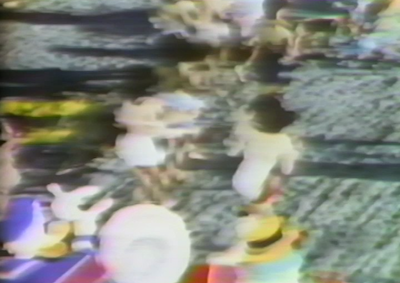Admission is free. No advance reservations. Your seat will be assigned to you when you pick up your ticket at the box office. Seats are assigned on a first come, first served basis. The box office opens one hour before the event.
This program provides a selection from 60 videos Raphael Montañez Ortiz made between 1984 and 1997, using laser discs, a computer with joystick, an electronic oscillator and a U-Matic recorder. Ortiz would explore brief passages from a commercial film, using the joystick to move back and forth within the sequence as he recorded onto ¾-inch U-Matic tape. These videos are the result of a real-time editing process, like an improvisational dance or concert, rather than the post-production editing of footage. Ortiz would often work with and record a passage several times before he felt he had found the essence of the scene. The videos here focus mostly on Hollywood features from the 1930s to 1980s and Ortiz’s interest in exploring the unconscious of Hollywood romance, the middle-class family and the choreography of violence and power. Ortiz often returned to certain films and directors, especially Orson Welles. The last part of the program looks at later videos that drew upon scenes from two or more source films, including features, documentary and television footage, suggesting a broader exploration of media culture rather than an opening up of specific canonical films.
Kiss and Tell
The Kiss
U.S., 1985
Source: A seven-second passage from Body and Soul (1947) by Robert Rossen: the end of a scene in which the painter and boxer begin to fall in love and kiss, and less than a second of a street scene.
Digital file, b&w, 6 min.
Here's Looking at You Kid
U.S., 1991
Source: The ending scene in Casablanca (1942) by Michael Curtiz with Humphrey Bogart and Ingrid Bergman, and footage of the Crossroads nuclear test.
Digital file, b&w, 4 min.
That's the Way I Feel About Him
U.S., 1992
Source: A five-second passage with Marlene Dietrich in The Spoilers (1942) by Ray Enright. The film, set in Nome, Alaska, also stars John Wayne and Randolph Scott.
Digital file, b&w, 3 min.
That’s Too Much
Expulsion from the Garden
U.S., 1991
Source: Two scenes from King Kong (1933) by Merian C. Cooper and Ernest B. Schoedsack: Jack Driscoll and Ann Darrow kissing on the boat and a shot of King Kong grunting.
Digital file, b&w, 4 min.
Beach Umbrella
U.S., 1985
Source: Disney’s live-action/animated musical Three Caballeros (1944) by Norman Ferguson in a scene in which Donald Duck, José Carioca and Panchito Pistoles dive bomb Brazilian women on a beach. The cartoon American duck, Brazilian parrot and Mexican rooster were meant to symbolize a hemispheric wartime alliance under the Good Neighbor Policy. Here, Ortiz draws out the aggressive sexuality underpinning the film’s message.
Digital file, color, 8 min.
That’s Too Much
U.S., 1996
Source: The Swedish comedy Dollar (1938) by Gustaf Molander, starring Ingrid Bergman (who is not in the passage used by Ortiz).
Digital file, b&w, 4 min.
Men Dancing
Dance No. 1
U.S., 1985
Source: A 10-second passage in Citizen Kane (1941) by Orson Welles of Mr. Carter shaking hands with Bernstein when he realizes Kane will take over his office.
Digital file, b&w, 4 min.
Dance No. 6
U.S., 1985
Source: Scene from King Kong (1933) by Merian C. Cooper and Ernest B. Schoedsack in which filmmakers and sailors search a boat for Ann Darrow, who is missing.
Digital file, b&w, 3 min.
Dance No. 22
U.S., 1993
Source: The Marx Brothers’ A Night at the Opera (1935) by Sam Wood.
Digital file, b&w, 7 min.
Multiple Orson Welles
Election Promises
U.S., 1988
Source: Scene from Citizen Kane (1941) by Orson Welles.
Digital file, b&w, 8 min.
Mischievous Shadows
U.S., 1988
Source: Scene from Citizen Kane (1941) by Orson Welles.
Digital file, b&w, 4 min.
Raw Oysters
U.S., 1991
Source: Three scenes from The Magnificent Ambersons (1942) by Orson Welles.
Digital file, b&w, 6 min.
Putting Films into Dialogue
My Father's Dead
U.S., 1991
Sources: A child shouting “My father’s dead!” from Excalibur (1981) by John Boorman, obscured images of a caveman and cavewoman having sex from Quest for Fire (1981) by Jean-Jacques Annaud, and a building exploding in High Plains Drifter (1973) by Clint Eastwood.
Digital file, color, 3 min.
The Critic
U.S., 1996
Sources: Moby Dick (1956) by John Huston, the scene with Captain Ahab (Gregory Peck) attacking the white whale; and Citizen Kane (1941) by Orson Welles, with Kane asleep at the typewriter.
Digital file, b&w, 12 min.
It’s Coming Up
U.S., 1997
Sources: A 1930s exercise film showing a woman on a mechanical horse (used in other Ortiz videos), a scene from The Bride of Frankenstein (1935) by James Whale, and footage of an erupting volcano.
Digital file, b&w and color, 5 min.
Total running time: approx. 100 min.






 Mobile Navigation
Mobile Navigation

